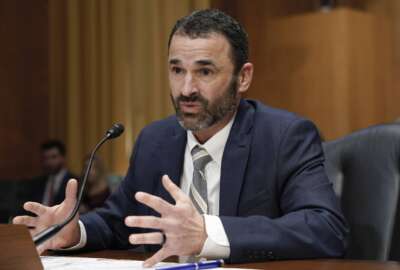Hubbard Radio Washington DC, LLC. All rights reserved. This website is not intended for users located within the European Economic Area.
Obama administration looks to standardize agencies’ FOIA regulations
Amid a Congressional push to add new teeth to the 1966 Freedom of Information Act, federal officials insist they are taking steps on their own to make sure agen...
wfedstaff | April 17, 2015 6:23 pm
If you’ve seen one federal agency’s approach to the Freedom of Information Act, then you’ve seen one federal agency’s approach to the Freedom of Information Act.
Yes, there is one federal law, but the 99 agencies that are subject to FOIA each have their own rules that dictate how they handle public demands for information. But there’s a move afoot to change that, executive branch officials said Tuesday as Congress considers legislation that would give FOIA more heft and leave agencies with fewer workarounds.
Starting this spring, the Justice Department’s Office of Information Policy will begin interagency talks geared toward removing some of the inconsistency and confusion FOIA requesters face when they deal with multiple agencies. The objective is to draft a single regulation that would apply across government.
“The idea would be to streamline and standardize some of the core, procedural parts of administering the FOIA, making them the same across the agencies to the extent we can,” Melanie Pustay, OIP’s director told the Senate Judiciary Committee. “That, I think, would have a direct, day-to-day impact on the common FOIA requester. It’s a new idea. Right now, we have 99 agencies with 99 sets of FOIA regulations, so one of our initiatives is to explore the legal feasibility of doing this.”
Beyond legal feasibility Pustay said the working group will also likely face a challenge in drafting a common regulation that still allows enough flexibility for agencies’ unique mission needs. She said it would likely take one or two years for such a regulation to be finalized.
Besides moving toward a standard regulatory framework for FOIA, federal officials say they’re also working to rationalize internal business procedures between agencies to make the overall request processing system more efficient. DoJ will lead a series of interagency working groups this year to help agencies reach agreement around best practices, Pustay said.
And the National Archives and Records Administration’s Office of Government Information Services, whose staff of seven workers serves as the government’s FOIA ombudsman, says it’s trying to help agencies share the technological nuts and bolts behind the processing of FOIA requests.
Only eight agencies using FOIAOnline website
The FOIAOnline website, which OGIS and other federal collaborators launched a year and a half ago, lets users submit their requests online through a common interface that’s intended to serve every agency and allows users to track the progress of their requests. But agencies have not exactly embraced the concept. Only eight federal entities are currently on board. The Department of the Navy migrated its FOIA processing to the shared system last month, but the Treasury Department left the project last year in favor of its own portal.
“The goal is to have a shared service,” said Miriam Nisbet, the director of OGIS. “It is to accommodate both small agencies and large agencies, and we have not had an issue doing that. In other words, whether it’s a small agency or a large one, the system seems to be working quite well. We’ve heard good feedback from requesters, and we think it’s going to be a good model for looking at either continuing to expand it, which we hope is going to happen, or to the next version that comes along.”
Open government advocates and other members of the FOIA requester community say it’s all well and good to move toward more advanced technology and standard business practices, but overall, they’ve been severely disappointed with the Obama administration’s track record on FOIA.
Moving requests through the system more quickly won’t do much good if agencies stick to the practice of withholding information on the basis of overly broad interpretations of the exemptions in the FOIA law, said Amy Bennett, the assistant director at OpenTheGovernment.org.
“Foremost among these, the open government community would like to see Congress put tighter boundaries around the government’s overuse of FOIA’s Exemption 5, or, as many requesters like to refer to it, the ‘We don’t want to give it to you’ exemption,” she said. “Exemption 5 is intended to protect the government’s deliberative process and was intended to have narrow application. Over time, federal agencies have expanded the scope of Exemption 5 to the point that it covers practically anything that is not a final version of a document. In one recent egregious example, the Central Intelligence Agency denied a request from the National Security Archive for a copy of the CIA’s internal history of the 1961 Bay of Pigs disaster. The request was denied despite the fact that the draft is connected to no policy decision by the CIA, and it’s related to events that occurred more than 50 years ago.”
Bennett’s coalition and other organizations want Congress to make changes to FOIA so that agencies would have to release information unless they could demonstrate to a court that doing so would create “foreseeable harm.”
The House passed a bill two weeks ago that would, in fact, make that change.
Among several other amendments to the current FOIA law, the FOIA Act, sponsored by Rep. Darrell Issa (R-Calif.), would beef up the authority of OGIS and make it more independent from the executive branch, require agencies to post any information they’ve revealed under a FOIA request online and increase appeal rights for people whose FOIA requests are denied.
DHS and EEOC account for 85 percent of FOIA denials
Pustay defended the government’s FOIA performance. She said two agencies accounted for 85 percent of the FOIA denials under Exemption 5 — the Department of Homeland Security and the Equal Employment Opportunity Commission — and that most of those denials were legitimate protections of attorney-client privilege.
“I think the agencies are robustly implementing the law,” she said. “That’s not to say that there are not further improvements that can be made, but we have, across the government, record-high numbers of incoming FOIA requests, and yet agencies processed more FOIA requests last year than ever before. In the past five years, we have agencies releasing records in full or in part in over 90 percent of cases. We have many, many examples of agencies putting records up on their websites to help make information available to the public without the need for a FOIA request. So we have seen a lot of concrete steps that agencies have taken to improve access to information.”
While agencies have done a better job of processing requests through better use of technology and process improvements, the federal government’s progress toward reducing agency backlogs has been uneven. Seventy-three of the government’s 99 FOIA-subject agencies now have a backlog of less than 100 cases, and 29 have no backlog at all.
But a handful of agencies still have gargantuan backlogs. The Department of Homeland Security holds the crown at the moment with more than 50,000 pending cases, mostly because of a large and growing influx of FOIA requests about immigration matters, the department said in its annual FOIA report last month. And open government advocates find it irksome that the Justice Department’s own backlog is going up instead of down, since that agency is supposed to serve as the guiding light on FOIA for the rest of the government.
“This ‘Do as I say, not as I do’ problem is exacerbated by the fact that even the department’s high-visibility leadership offices saw their own numbers of pending FOIA requests increase by almost 4 percent rather than decrease,” said Daniel Metcalfe, the executive director of American University’s Collaboration on Government Secrecy project. “This makes it impossible to lead by example.”
RELATED STORIES:
Agencies receive failing grades for processing FOIA requests
FOIA backlog grows even as agencies process more requests
New FOIA portal promotes transparency, eases agency interactions
Copyright © 2024 Federal News Network. All rights reserved. This website is not intended for users located within the European Economic Area.
Jared Serbu
Jared Serbu is deputy editor of Federal News Network and reports on the Defense Department’s contracting, legislative, workforce and IT issues.
Follow @jserbuWFED





